Site JIG
ALASKA
Delta Battery
2nd Missile Battalion, 562nd Artillery



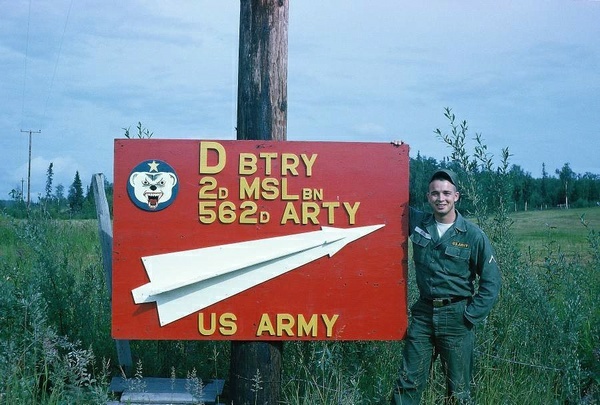
Updated 05 August, 2010




Updated 05 August, 2010
D Battery, 2nd Battalion, 562nd Artillery was one of five Nike-Hercules missile firing batteries that were deployed to provide a defensive ring of supersonic fire around the Fairbanks/Eielson AFB complex during the height of the Cold War. This webpage is an attempt to preserve some memory of the place and time that is rapidly disappearing. If you came across this webpage by means other than the link from the NIKE-HERCULES ALASKA INDEX page, you may wish to go there first for a little background information before proceeding. Please CLICK HERE to do so, then follow the link to Site JIG back here. Thank you.
What is an AADCP?
AADCP (pronounced "ad'cap") is an acronym that stands for Army Air Defense Command Post. The purpose of the AADCP is to provide command and control of the air defense artillery (ADA) fire units assigned to it. This involves coordinating the defense by assigning individual targets to the fire units. Other duties include serving as a communications center for disseminating and deciphering encrypted messages between higher command echelons and the batteries, and coordinating with Air Force and NORAD assets. To learn more about the workings of an AADCP from an insider's viewpoint, you can visit the Site POINT webpage by clicking HERE.
The 2nd Battalion, 562nd Artillery's AADCP was positioned near Site Jig with D Battery, just as the 1st Battalion, 43rd's AADCP was positioned near site Point with A Battery, 1/43 in the Anchorage/Elmendorf AFB/Ft. Richardson area to the south.
One Alaska Nike veteran notes: "The Alt AADCP that was at Jig site was about 500 yards or a little more to the north of "D" Btry, When I got there it had an AN/TPS 1D radar set up on 2 Nissie buildings. Then we got a new building with a fiberglass dome and changed to an AN FPS-36 and later to an ANFPS- 61. That was about the time they first set up the firing range and fired the first Hercules outside of the lower 48."
The IFC area consisted of the various radars, communications, and command and control equipment. Alaskan Nike sites incorporated most of this into one main building that also served as barracks, dining facility, emergency medical clinic, convenience store, and recreational facility. That is a lot to fit into one building and needless to say, being cooped up and isolated in a place like that through the middle of an Alaskan winter can result in a touch of "cabin fever".
The launcher area consisted of a double-fenced and well patrolled perimeter that contained two launcher buildings where assembled missiles were stored on rails and launchers, ready to roll out and fire if need be. Other buildings included guard dog kennels, the launch control building, and warhead and rocket motor storage bunkers. To ensure that the angular slew rate of the MTR's (Missile Tracking Radar] antenna mount was not exceeded by the speed of the ascending missile, the launcher area had to be sited roughly one mile away from the IFC area.
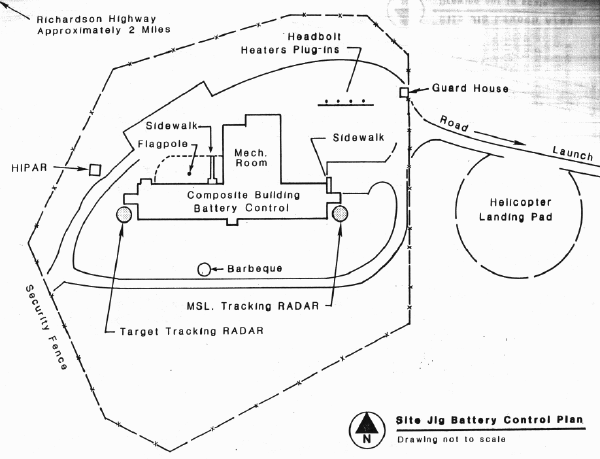
The northern lattitudes of the Alaskan Nike sites provide natural beauty, but the spectacular vistas come at a price. This narrative from another veteran that served at site Jig in the early days will give the flavor of the experience:
"I arrived at D battery in March of 1963 when the worst part of winter was over, thank goodness! The temps in the winter would reach 50 degrees below zero if I remember right. I stuck my head out the door one winter day since it had been 2-3 weeks since I even went out. It was around 50 below that day and I happend to rub my mustache and half the hair broke off! Needess to say, the rest of the mustache came off the next morning when I shaved. Life was difficult at times especially in the winter."
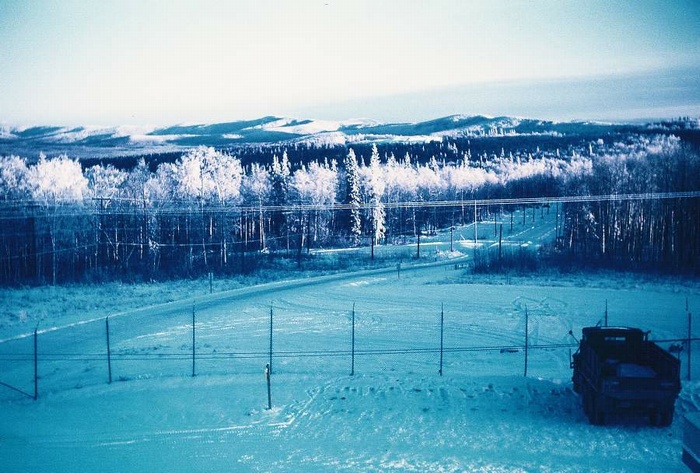
And here is the opposite view, toward the IFC area.
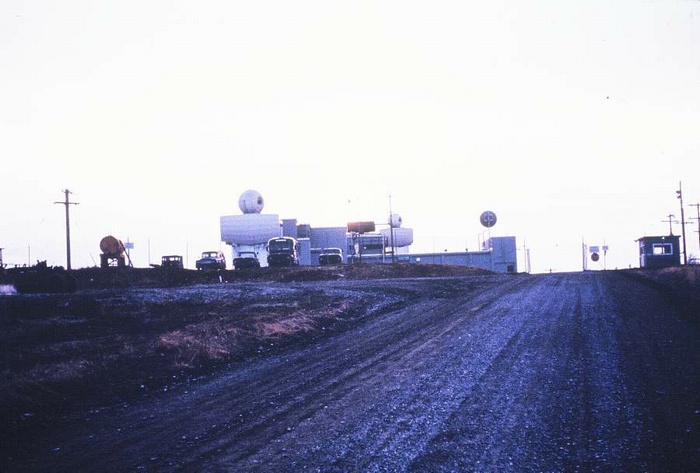
At left below is a view of the TTR (Target Tracking Radar) antenna tower, looking west toward the Tanana river. Mount McKinley is just out of view to the left. At right is another view looking towar the northwest.
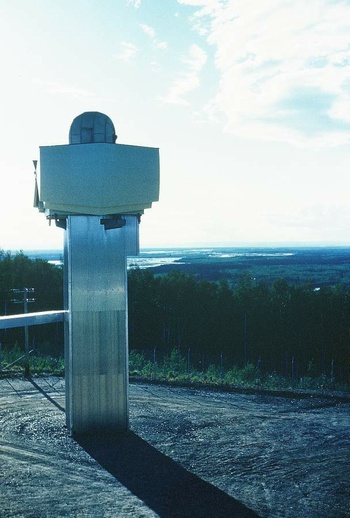
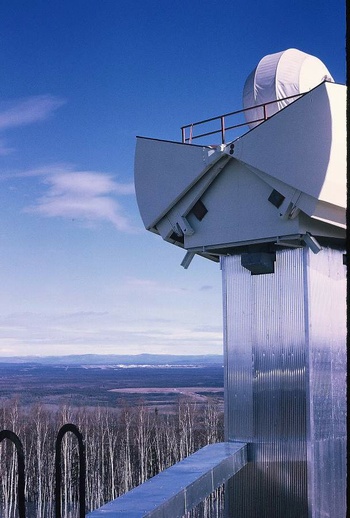
"Halfway through winter, I remember looking out the window for the sun and all I saw was a little pink on the horizon at 10 in the morning. By 2 in the afternoon, it traveled 90 degrees around the horizon and then the pink "sunshine" dropped out of sight. The rest of the 24 hour day it was pitch black.
"Summer was short, but the light 24 hours of the day was nice in the middle of summer. The darkest it would get is like sundown or early evening, and then the sun started to come up at around 2 in the morning.
"Daytime temperatures during the summer would be in the 80's and low 90's and really muggy. I remember hiking in the woods and my boots would be soaked with water since the ground was so moist. Also burned in my memory is the fact that nobody ever warned me about the mosquitos! We were playing volleyball one afternoon when my forearm started to itch. I gave it a scratch and my arm was covered with streaks of blood! Apparently these mosquitos can live at the base of the trees through winter and then resurrect in spring, and we couldn't get repellant at our little PX we had in the dayroom on our site."
The living conditions of the men serving at Site JIG were similar to those at the other Alaskan Nike sites. The narrative continues:
"The missile men and radar ops worked a day off and day on and I was glad I was a radar operator as I got to stay in the same building and the missile men had to be transported to the missile area a mile away (not much fun in the winter). Our radar vans were installed inside the building and were complete as used in the field, but with no wheels. One van housed the aquisition radar and computer (and the captain's position) and the other housed the MTR (Missile Tracking) and TTR (Target Tracking) radars."
At left is a mid-1970's view into the tracking van at Site SUMMIT, and at right is a view of the TTR console.
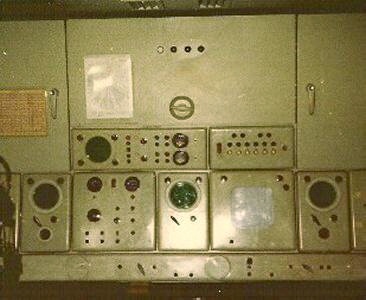
At left below is a photo showing the Long Range, Fire Control, and Short Range positions.
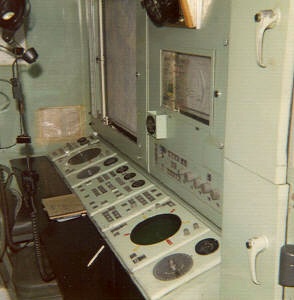
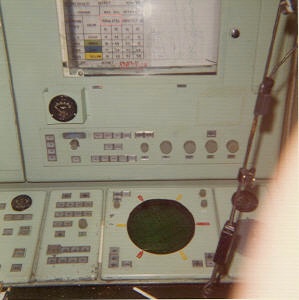
Some communications equipment and another of the tracking consoles...
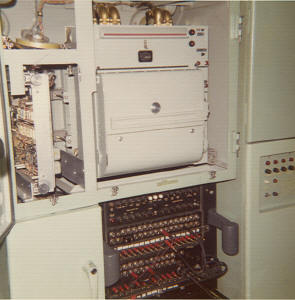
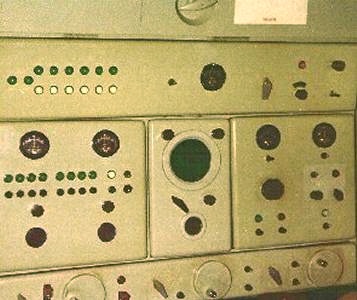
Here is a view of the"Tipsy Dome. "I never went out there since the job didn't call for it and I guess I wasn't curious enough. The helicopter pad was around here too I think. I just remember the vet flying in to check over the MP's guard dogs. And if I remember right, when taking the dogs around the fence line during the winter, the MP's would bring the dogs into the orderly room every 20 minutes or so to let the dog's paws warm up, and then back out again!"

This JIG veteran continues: "The Captain wasn't there most of the time as we did our drills without him. One day he sure showed up fast when we locked on an unknown aircraft whose IFF (Identification Friend or Foe equipment) didn't signal it as a "friend". He almost had to flip the fire switch till we called the Fairbanks airport and found out it was a commercial airliner with a broken IFF. The captain sure had beads of sweat on his brow! I missed the major excitement since my position was in the other van."
Part of maintaining operational readiness for every Nike Hercules battery was the requirement to perform Annual Service Practice, which included the firing of a live missile:
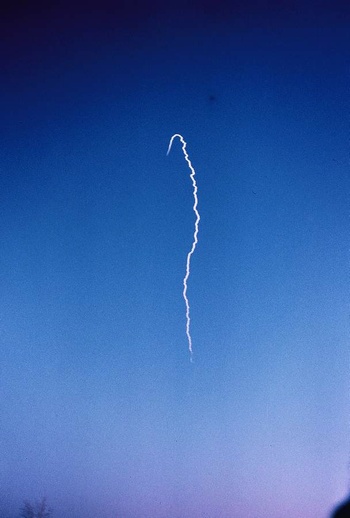
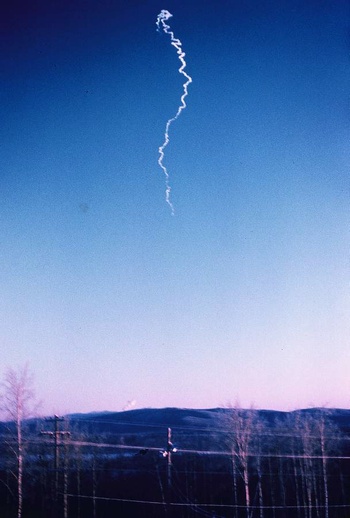
"D battery had about 65-70 personnel which included missile and radar personnel, as well as cooks, motor pool and mechanics, MP dog handlers, a medic, and a quartermaster. There were 4 of us radar guys to a room and we when we had to work night van guard, we had to sleep during the days. I remember one of my room mates putting masking tape around the shade in our room to block out the sunlight so he could sleep. We had to be pretty tolerant of each other because our rooms were small. Each of us had a tall steel locker and a foot locker and we had bunk beds and a small table with a chair."
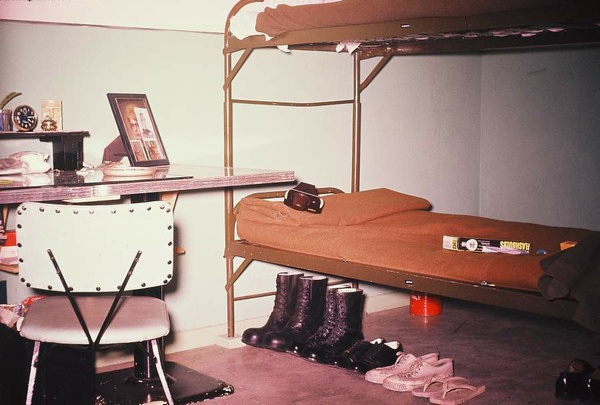
"We had a little "PX" where we could buy peanuts, "beanie weenies", cigarettes, and even beer in the evening. For the life of me, I can't remember how we were supposed to heat up the beanie weenies?!"
Barbecues and cookouts were a popular option on the Nike sites, just like everywhere else that hungry men are found.
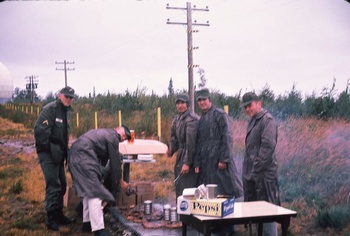
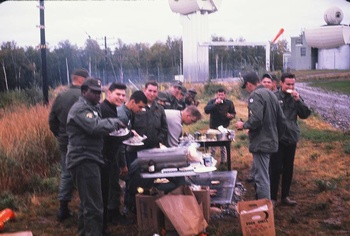
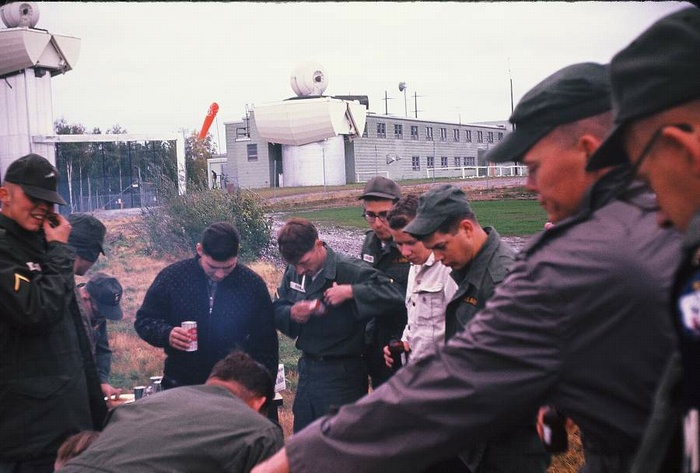
"All non coms were on the KP roster and the food was fair most of the time. We would only get a worm in the lettuce now and again. KP wasn't bad and a nice change fron my regular duties. I got plenty to eat and work was light. The hardest thing we did was unload the rations truck when it came to deliver the food. I swear the lettuce heads were like bowling balls because the rations truck wasn't heated very well. I remember someone telling me to take a glass of water (in the winter of couse) and get out on the deck behind the mess hall, and throw the water up in the air. I think only a drop or two hit the ground and the rest went into a vapor and blew away! Kind of a winter thing I guess. It sure was short lived entertainment!
"We had a psychiatrist living with us on the site for a month, but just during the day as he stayed in town at night. I guess he was checking us out to see if one of us was "losing it". He missed a lot of the dysfunction by not spending the night at our place! The Army must have paid him pretty good to stay on the site just during the day.
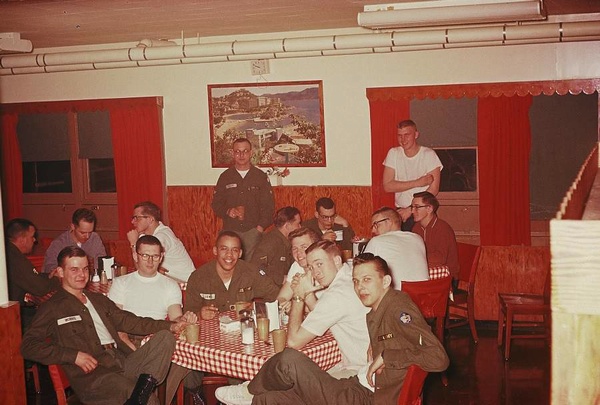
"Coffee call at 9 pm. Sometimes the mess hall would be open for a short time around 9pm for coffee and maybe leftover dessert from dinner."
"We were 35 miles from Fairbanks and every now and then one or two of us could hitch a ride to the AFB or Fairbanks with one of the off site personnel who had families on base or in town. Otherwise we stayed on site or got a short ride to the little bar, down on Richardson Highway in the middle of nowhere, with no knowledge of how we would get back up the hill to our site. And get the name of the bar - the "IT'L DO". I guess it did! It was the only thing around for miles except a ranch or two.
"I showed the movies, which were shipped to us by the Air Force and were a little current, but just a little, and we charged a dollar to see the movie. The movie was the highlight of the evenings for a couple of days since we had no TV, let alone anything like a DVD! We got a little radio from Fairbanks and now and again polka music from Russia which was 700 miles away I think. I picked up the mail at Eielson Airforce Base 14 miles away. Eielson AFB was what we were supposed to be protecting with the five missile sites surroung it. Doing these things when I was off duty proved to be better than going to the "IT'L DO" down on Richardson Highway.
"Looking back, I wish I had traveled more in the summer. What a great opportunity to do so in Alaska! I'm no hunter, but we could get hunting licenses and tags for game free because we were military. The Air Force had a couple of places for us to go during summer; a lake or two to fish at, complete with a cabin to stay overnight in. At Valdez, on the coast south of our site, we could come and fish or just go boating (no motors, so you had better have some cooperative boatmates). Valdez is spectacular looking much like a fiord in Norway or places like that.
"We traveled in a miltary pickup truck to Valdez and stayed a couple of days there. On our way back to the battery, the guy who was driving came to an abrupt halt and the next thing I knew, there was a dead bear in the back of the pick up with a couple of us. The driver was a hunter and he just happened to see what he wanted off the highway. The other guy and I in the back of the truck had another "passenger" riding with us for a couple hundred miles back to the site. This thing was still bleeding and my clothes were soaked in a couple of spots. And I learned during the trip that bears really smell! Nobody told me that either! The one saving grace was when we got back to D battery, our hunter, who was from another site, promised he would give us a taste of bear meat. It sounded good, but we never saw this guy again.
"Every now and then we would see a U2 spy plane land at Eielson AFB since the highway was close to the landing strip in a couple of places. The Air Force MP's would run out to the planes and retrieve a canister from the plane and then disappear with it. I think it was a film canister from the plane's latest flight. One of our guys took a photo of one of the landings. He never got it back from developing; the lady at the counter in the PX just said 'You know better than to take photos of that!'"
"One event I will never forget is when we got word of the assasination of president Kennedy. Looking back, I guess we did have a TV with one channel in the day room. We could get the weather and the news I think. It was a solem time and very quiet around the site. There was a sense of shock and saddness. I guess we really couldn't honor the man except to put on a memorial parade the next day at Fort Wainwright, the Army fort just outside of Fairbanks. We were bussed down to the fort. We had to get on our full winter gear because it was very cold, and we were tripping over each other because of the foot deep snow we were marching in. We had our fur ruff winter hood closed most of the way to keep the cold out so we couldn't see very well. Kind of funny and yet not!
"As winter progressed, we were told we had to do a 'winter indoctrination'. If our site were ever attacked by an enemy, we might have to bail out of the site and camp in the woods. Soooo, we were told we had to camp out for three nights, lean-tos and all. It must have been a warm spot in winter which we were all thrilled about; I think it was 15 degrees during the day. We lived on rations that were made for the troops in 1941. Not much of a menu; Canned Spagetti, soups, beef stew, etc., and the highlight was 1941 M&M's and canned cigarettes. Luckys and Camels, no filter of course.
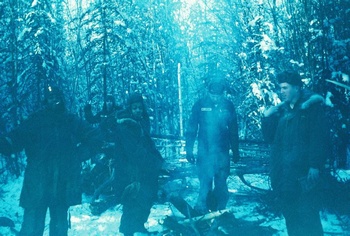
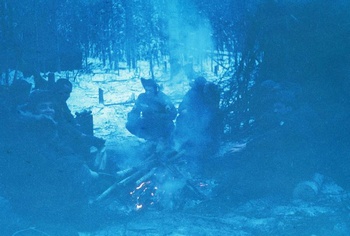
I was smoking at the time and tried one of the 20-something year old cigarettes. Just one though. I think even if it had a modern filter I couldn't have handled it! We were called back to the site early because of some minor crisis so we only had to spend one night out there. Nice!
"I was at D Battery during the 1964 earthquake. If I remember right, no missiles were destroyed, however I was IFC personnel and all we had to do was re-level the MTR and TTR, etc." (Reference is made here to the massive destruction the earthquake caused in the Anchorage area and the near-catastrophy at A Battery, 4-43 ADA at Site POINT.)
"All in all, I don't regret the Nike site experience. It seemed like a long 18 month's tour, but I can see the Army made it as tolerable as possible under the circumstances. "As each of our tours came to an end, it was always kind of a bittersweet time for the man leaving for home and the men he was leaving behind. We all didn't get along at times, and yet there was a bonding of some kind and some saddness leaving those behind, and sadnees seeing someone leave. THIS EXPERIENCE I WILL NEVER FORGET AND NEVER REGRET."
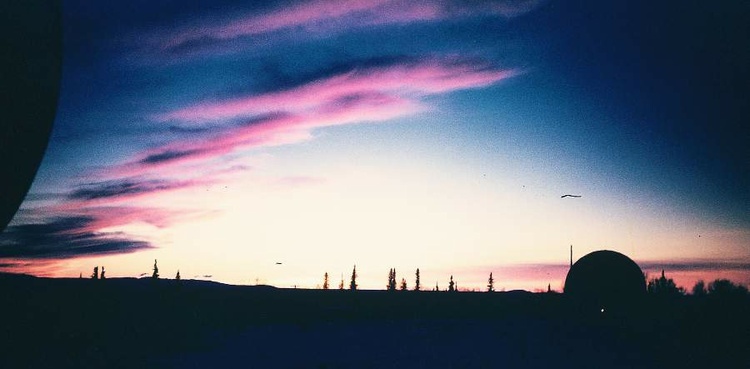
- Juliet Tango Sierra
January, 2005
